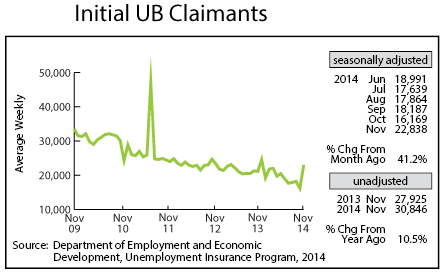by Dave Senf
December 2014
Note: All data except for Minnesota's PMI have been seasonally adjusted. See the feature article in the Minnesota Employment Review, May 2010, for more information on the Minnesota Index.
The Minnesota Index increased 0.2 percent for the second straight month in November. Minnesota's economic expansion has slowed over the last two months according to the index, having increased by 0.3 percent each month between May and September. Job growth, however, continued at a robust pace, the unemployment rate dipped again, and average weekly manufacturing hours inched up in November. Minnesota's index in November is up 3.2 percent from a year ago, matching the 3.2 percent gain in the U.S. index since last November. Minnesota's index has, however, been advancing slower than the U.S. index over the last few months.
Minnesota's economic expansion is now five years old with most signs pointing to another year of solid economic growth for 2015. The Minnesota Index is up 15.2 percent over the last five years which exceeds the 13.9 percent U.S. index increase over the same time period. The 15.2 percent gain is substantially larger than the 10.6 percent jump experienced during the six-year expansion from 2002 to 2008. Minnesota's index increased 10.6 percent between 2002 and 2008 while the U.S. index increased by 13.9 percent over the same span.
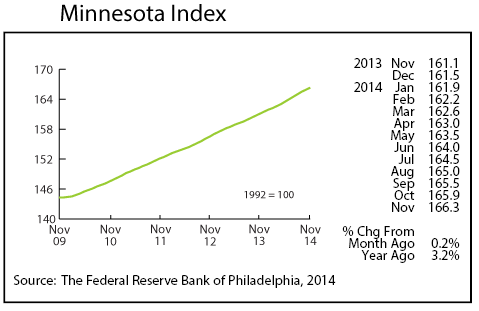
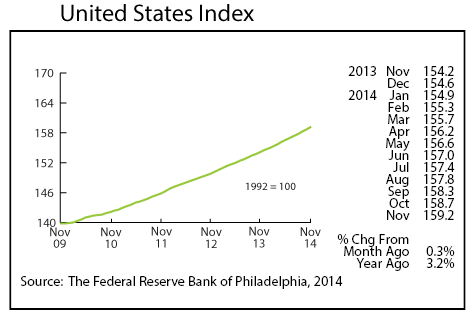
Adjusted Wage and Salary Employment increased sharply for the fourth month in a row in November with 6,600 jobs added. November's job report might have been even stronger if not for the early winter weather which probably explains most of the 3,600 jobs lost in Construction. The drop in Construction jobs dragged goods producing employment into the negative for the first time in four months. Significant job loss occurred in Other Services and in Trade, Transportation, and Utilities. Hiring was strong in Leisure and Hospitality, Financial Activities, Professional and Business Services, Government, and Educational and Health Services. Manufacturing employment was up for the fifth straight month.
Minnesota's unadjusted job growth over the year stayed at 1.8 percent which was slightly below the 2.0 percent gain recorded nationally. Minnesota's over-the-year job growth has now lagged behind national growth for three consecutive months.
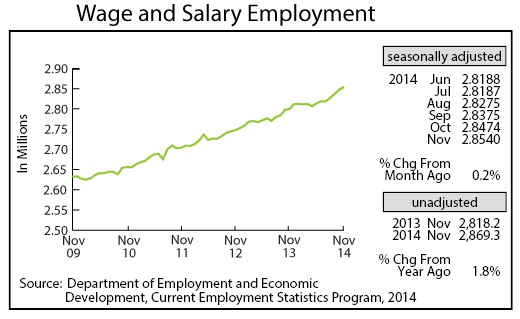
Minnesota's adjusted online Help-Wanted Ads jumped to a record high of 128,100 in November, topping the previous high of 125,500 in August. The level of job advertising in Minnesota climbed 5.8 percent over the month, outdoing the 3.3 percent national increase. Help-wanted ads online were up 12.3 percent over the year compared to 7.2 percent for the U.S. Minnesota's share of job advertising (2.4 percent) continues to exceed the state's share of total employment (2.0 percent).
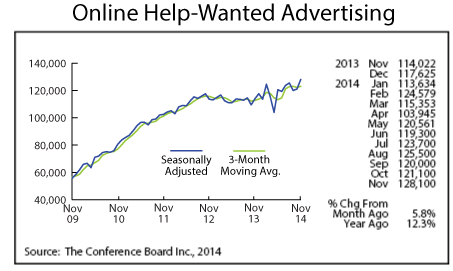
Minnesota's Purchasing Managers' Index (PMI) slipped for the fourth time in five months in November, reaching its lowest reading since January. November's 58.0 reading still points to solid economic growth for the state during the first half of 2015, but the pace will likely be slower than the second half of 2014. The Mid-America Index, a leading economic indicator for a nine-state region stretching from North Dakota to Arkansas and including Minnesota, dipped slightly to 51.3 percent in November while the corresponding national index slipped to 58.7. November was the first time in 12 months that Minnesota's index was below the U.S. index.

Adjusted Manufacturing Hours rose for the first time in three months, inching up to 41.6 hours. While November's factory workweek is down from the 41.9 hour workweek experienced a few months ago, Minnesota manufacturing hours remain healthy by historical standards.

Manufacturing Earnings tailed off for the third month in a row, falling to the lowest level in almost two years. November's $823.94 weekly factory paycheck (seasonally and inflation adjusted) is down 2.5 percent from last November. The over-the-year drop in paychecks seems inconsistent with the widely held belief that qualified manufacturing workers are hard to find.
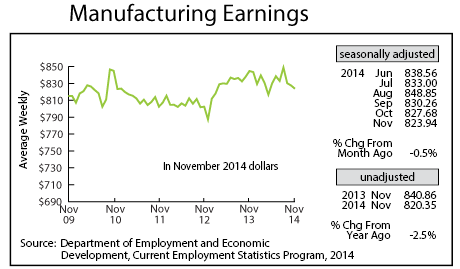
After peaking in May, the Minnesota Leading Index has dropped in four of the last six months including November. The waning leading index suggested that the rate of economic growth in the state will be slowing over the next six months. That prediction is consistent with the recent decline in Minnesota's PMI.
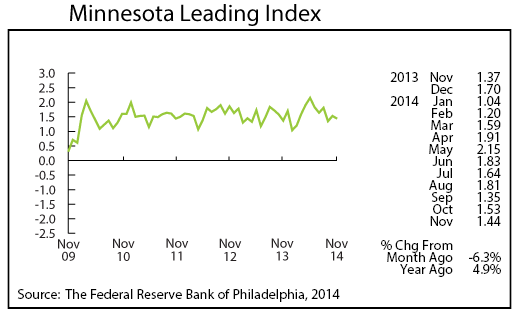
Adjusted Residential Building Permits fell off the shelf in November, plunging 40.2 percent to 854, the lowest level since May 2012. Hopefully November's sharp decline resulted primarily from the early winter weather. The biggest economic disappointment in 2014 has been the slower-than-expected increase in home building activity.
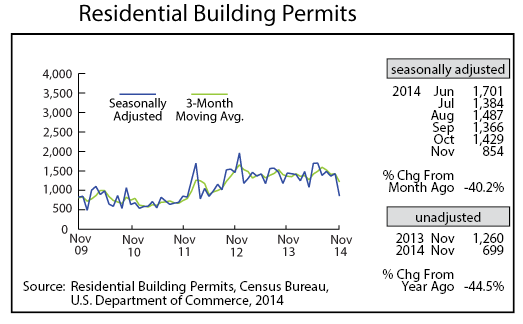
Adjusted Initial Claims for Unemployment Benefits (UB) spiked unexpectedly in November, skyrocketing to 22,838. Initial claims haven't been that high since last December. The early onset of winter in November may be behind the initial claims surprise.
